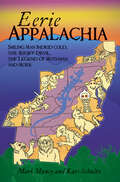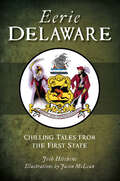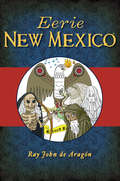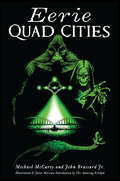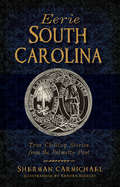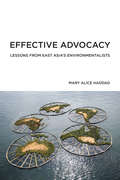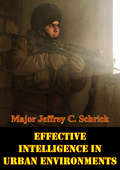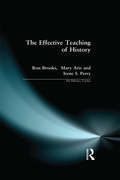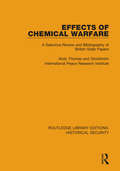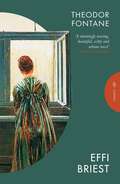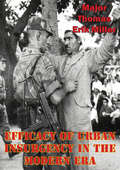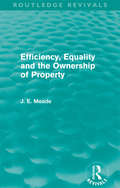- Table View
- List View
Edwina's Husband
by Agnes AlexanderTo stop her uncle, Reverend Hezekiah D. Thorn from forcing her to give her sixteen month old son to a childless couple in his church, Edwina Thorn Singleton flees to New Mexico to find Wyatt Singleton, the father of her son and the man who she thinks is her legal husband. Wyatt had no idea that the pretty little woman he pretended to marry would show up and turn his life upside down, but show up she does. At first he tries to rid himself of her, but it isn't long until the baby has captured his heart and soon after, he finds himself falling for Edwina, too. He is plotting to find a way to make their marriage legal without her ever knowing she's been duped when things become more complicated. Not only does he have to deal with a woman who is determined to run Edwina off so she can marry him, squatters on his ranch and a murder someone is trying to pin on him, but the evil uncle shows up to force Edwina and the baby back to Virginia. Wyatt began to wonder if the fates have decided to forever keep him from becoming Edwina's Husband.
Een Giftig Hart
by Barbara Risoli Yvonne GlasbergenBoekbeschrijving Een Giftig Hart Een buitengewoon liefdespaar in het Frankrijk van 1788 Het verhaal speelt zich af in de zomer van 1788, in het de op de proef gestelde Frankrijk van voor de Franse Revolutie. Men is in afwachting van de dag waarop de Staten-Generaal bijeen zullen komen, voorafgaand aan de bestorming van de Bastille. Hoofdpersonen zijn Eufrasia, dochter van graaf Xavier des Fleuves - een trots lid van de fysiocratische aanhangers van de Verandering - en Venanzio, een huurmoordenaar met een twijfelachtig verleden. Na het mislukte huwelijk van het meisje ontmoeten de twee elkaar en ontstaat een hechte band tussen hen. Zij leggen hun zielen schaamteloos bloot en zijn tot alles bereid om op te komen voor zichzelf, over de ruggen van anderen. Eufrasia's verzoek om haar eigen moord te ensceneren om niet het klooster in te hoeven, en de uitvoering van deze dienst door de bandiet, geeft elk van een hen een nieuwe identiteit. Zij houden zich schuil tegen de duistere achtergrond van het roerige Frankrijk, dat gebukt gaat onder de onophoudelijke sneeuwval van de winter van 1788. Op dit punt speelt het verhaal zich af tussen Nanterre, een gehucht in de buurt van Versailles, en Bretagne, de geboortegrond van de hoofdpersonen. Eufrasia wordt de Weduwe, een vrouw die zich altijd schuilhoudt, strijdbaar tot het uiterste, een behendig gokster en smokkelaarster die de opkomende revolutie van wapens voorziet. Venanzio geeft zich uit voor graaf Stolfo Rues, uit een niet-bestaand geslacht. Een serie toevalligheden brengt hen opnieuw bij elkaar, waarbij de liefde tussen hen langzaam opbloeit in de wederzijdse angst om afgewezen te worden. Maar belofte maakt schuld en....
Een gids voor kinderen over Israel
by Linda HendersonIsraël is een fascinerende plek. Elk kind, elke tiener en elke volwassene moet weten waarom het Midden-Oosten belangrijk is. Als u Israël en haar buren begrijpt, zult u zien dat er meer in het Midden-Oosten is dan alleen oorlog en conflict. Dit boek kan je leven veranderen. Komt u niet op avontuur naar het Heilige Land?
Een kus in de kersttijd
by Christina McKnightLady Pippa Godfrey heeft een vreselijk seizoen achter de rug in Londen. Ze vlucht naar hun landgoed in Somerset om daar een rustige kerst door te brengen met haar ouders, ver van de spiedende ogen van de society. Maar voordat haar ouders aankomen op het landgoed, breekt er een storm los in Somerset en slaat haar hoop op een witte kerst de bodem in. De wegen zijn overstroomd en reizen is onmogelijk; ze zit vast en is alleen. Maar dan verschijnt er een modderige, boze en duivels knappe lord aan de deur die om onderdak vraagt. Lucas Hartfeld, de graaf van Maddox, is door zijn ouders, de markies en markiezin van Bowmont, gesommeerd aanwezig te zijn bij een feest in het midden van het land, ver van zijn herenhuis in Londen. Hij vermoedt dat er een heel andere reden achter schuilgaat dan alleen een feest op het platteland. Als hij door een storm niet verder kan reizen met zijn rijtuig, wordt hij gedwongen onderdak te zoeken bij het enige huis dat in de verre omtrek te bekennen is, een landhuis met de naam Helton House. Als Lady Pippa aarzelt om hem binnen te laten, doet hij wat hij geleerd heeft – hij eist dat ze hem en zijn bedienden onderdak biedt totdat de storm voorbij is. Maar de mooie vrouw boeit hem veel meer dan hij bereid is toe te geven. Kan hij een uitweg vinden uit het lastige parket waarin hij door toedoen van zijn ouders terecht is gekomen? Als Lady Pippa geconfronteerd wordt met deze arrogante, veeleisende lord, wordt ze overspoeld door herinneringen aan eerder bedrog. Kan ze deze moeilijke levenslessen vergeten en een kerstkus ontvangen van een volledig vreemde?
Een verdomd close-run ding: een korte geschiedenis van de Falklands-oorlog
by Russell Phillips"Het was een verdomde close-run ding" - Generaal-majoor Moore, commandant van de Britse landstrijdkrachten in de Zuid-Atlantische Oceaan In 1982 wist de gemiddelde Brit niet dat de Falkland-eilanden bestonden, laat staan hun status als een betwist Brits grondgebied vlak voor de kust van Argentinië. Dat veranderde toen de Argentijnen de eilanden binnenvielen en de kleine verdedigende macht overweldigden. Beide landen beweerden dat de eilanden van hen waren, maar nu dacht Argentinië dat de Britten ze zonder strijd zouden opgeven. Ze hadden het mis. Groot-Brittannië stuurde een taakgroep naar de Zuid-Atlantische Oceaan om de eilanden opnieuw te veroveren, en de korte, intense oorlog die volgde was - in de woorden van generaal-majoor Sir John Jeremy Moore - "een verdomd close-run ding." Deze korte geschiedenis vat de gebeurtenissen voorafgaand aan de oorlog en de belangrijkste militaire acties samen, inclusief details van een Argentijns plan om een Royal Navy-schip in de haven van Gibraltar te laten zinken (op het laatste moment verijdeld door de Spaanse politie) en een gewaagd Brits plan om SAS te landen soldaten in Argentinië om Exocet-dragende vliegtuigen te vernietigen terwijl ze nog op de grond waren.
Eerie Appalachia: Smiling Man Indrid Cold, the Jersey Devil, the Legend of Mothman and More (American Legends)
by Mark Muncy Kari SchultzGear up for a frightful jaunt into the darkest reaches of the ancient Appalachians. Folk deep within Appalachian hollers lean close to share stories of the inexplicable with hushed awe. Monsters rumbling in the hills. Strange lights darting through the pitch-black night sky. Horrible occurrences, almost ineffable in their bizarre tragedy. "Tall tales," you might say. But tell that to the Flatwoods monster in Braxton County, West Virginia. Or the Goat Man of Louisville--look into his humanoid eyes and let him know you don't believe. And what of those apparitions in Mammoth Cave's Corpse Rock, or the Satan-spawn known as the Jersey Devil? How do you respond when those mysteries confront? From metaphysical energy that swirls near the Serpent Mound in Ohio to Point Pleasant's Mothman legacy, Mark Muncy and Kari Schultz explore the dark history lurking in the shadows of Appalachia..
Eerie Arkansas (The History Press)
by Heather WoodwardThe Scary Side of ArkansasImmerse yourself in the captivating allure of Arkansas, where mysterious phenomena beckon the curious. Embark on a journey to the healing waters hidden within the lush landscape of the Ozarks. They possess extraordinary healing powers, drawing seekers of health and rejuvenation to their mystical waters. Venture into the realm of the enigmatic spook lights, where luminescent orbs dance and flicker, intriguing all who witness it. Are they the spirits of the doomed and departed or something more sinister? Join Heather Woodward on an extraordinary odyssey through the eerie corners of Arkansas, where the past intertwines with the present, revealing a tapestry of untold tales.
Eerie Delaware: Chilling Tales from the First State (American Legends)
by Josh HitchensUncanny stories, local legends and ghostly encounters from the First State. Delaware may be small, but every corner of it is filled with strange and unusual history. Horrifying tales of ghosts haunt places both old and new. The Castle contains many stories of mysterious specters, but the mystery of the house's first owners is the truly creepy tale. The legend of the Devil's Road, called a myth by some, will chill your bones and make your spine tingle. In a state so close to the sea, stories of murder and mayhem include tales of piracy and maybe even cannibalism. Delaware native and paranormal historian Josh Hitchens invites you to join him on a journey through the spooky side of the First State.
Eerie Edmonton
by Rhonda ParrishAn exploration of the spooky side of Edmonton. Full of ghosts and strange sights, Edmonton is a place rich in the paranormal. Or is it? Are there really spirits that lurk around Fort Edmonton and the provincial legislature? Do ghosts really haunt the halls of the University of Alberta, rushing off to classes that have long finished? Can paranormal echoes of the dark history of Charles Camsell Hospital still be felt within its walls today? What about the stories of the phantoms that loiter around the graveyards, bars, schools, and pools of the city? In this collection of more than forty stories, Eerie Edmonton reveals the truth in the tales people tell and shines a spotlight on the city’s dark shadows and colourful past. Join Rhonda Parrish and Rona Anderson as they compare personal accounts of hauntings and paranormal activity with documented history and their own on-the-ground investigations.
Eerie Georgia: Chilling Tales from the Mountains to the Sea (American Legends)
by Jim MilesGeorgia is a thoroughly modern state, known for its vibrant culture and bustling economy. Despite this veneer of normalcy, strange legends lurk around every corner. Former president Jimmy Carter's family consulted a psychic in an attempt to find one of the farm's wayward dogs. A Hall County ranch was plagued by mysterious cattle mutilations made with surgical precision. Eggs, alligators, turtles and frogs have rained down from the heavens across the state, from Columbus to Savannah. Evidence suggests that ancient seafarers regularly visited the Peach State centuries before Columbus reached the New World. Author Jim Miles explores these and many more in a collection of stories that can be found only in the Peach State.
Eerie New Mexico
by Ray John AragónNew Mexico's night sky generated speculation about alien visitation for centuries before the Roswell Incident of 1947. But the luminous spheres known as Bolas de Lumbre weren't the only evidence of unnatural phenomena in play. Locals have grown accustomed to stacking an unending list of questions against a disquieting tally of strange objects, unexplained sightings and unsolved mysteries that perplex scientists and confound skeptics alike. The original inhabitants of the land confidently claimed the distant stars as their ancestral home, but there is nothing remote about the fear many of the state's modern residents feel for the "Evil Eye" or a host of other supernatural threats. From notorious body snatchers to obscure ancient rituals, Ray John de Aragón examines New Mexico's eerie heritage.
Eerie Oklahoma
by Heather Woodward Rebecca LindseyWith a flash of green light, a portal opens up in the Beaver Dunes. But even the strangeness of another dimension struggles to compete with Oklahoma's hair-raising heritage. The woods still whisper of a woman with doe eyes and deadly hooves. Tulsa's ivy-covered Hex House remains haunted by the ghost of its infamously manipulative owner. From the traveling mummy of John Wilkes Booth to the grandma who seasoned plum cakes with arsenic, Heather Woodward explores the peculiar and petrifying portions of Oklahoma's past.
Eerie Quad Cities (American Heritage)
by Michael McCarty John Brassard Jr.Like the mighty Mississippi River that cleaves the Quad Cities, the region's history can trap the unwary in some unexpected eddies. Peer through the fog of the past to catch a glimpse of the Tinsmith Ghost of Rock Island or the river serpent with a price on its head. Get the back story on the Banshee of Brady Street, read the 1869 report on a Bigfoot sighting near East Davenport and run the numbers on local UFO activity. From phantom footsteps in the Renwick Mansion to a mausoleum heist in Chippiannock Cemetery, Michael McCarty and John Brassard Jr. trace a path through the shadowy heritage of the Quad Cities.
Eerie South Carolina: True Chilling Stories from the Palmetto Past
by Sherman Carmichael Kristen SoleckiMaster storyteller Sherman Carmichael is back with more mysterious tales from South Carolina--from Plantersville to Loris and from Beaufort to Clinton. Many of these stories have been told and retold throughout generations, like the red-eyed specter that roams the stairwells of Wilson Hall at Converse College or the haunted grave site of Agnes of Glasgow in Camden. In 1987, a construction company unearthed the bodies of fourteen Union soldiers from the Civil War--twelve of the bodies were found without their heads. The Abbeville Opera House has a chair that remains open to this day for a patron who visited long ago. Join Carmichael for these and many more rare and offbeat stories from South Carolina.
Effective Advocacy: Lessons from East Asia's Environmentalists (American and Comparative Environmental Policy)
by Mary Alice HaddadAn examination of successful environmental advocacy strategies in East Asia that shows how advocacy can be effective under difficult conditions.The countries of East Asia--China, Japan, South Korea, and Taiwan-- are home to some of the most active and effective environmental advocates in the world. And the governments of these countries have adopted a range of innovative policies to fight pollution and climate change: Japan leads the world in emissions standards, China has become the word's largest producer of photovoltaic panels, and Taiwan and Korea have undertaken major green initiatives. In this book, Mary Alice Haddad examines the advocacy strategies that persuaded citizens, governments, and businesses of these countries to change their behavior.
Effective Civil-Military Interaction in Peace Operations
by Sebastiaan Rietjens Gerard LuciusThis book contains unique, firsthand experiences of both the military and civilian actors involved in civil-military interaction processes. It presents lessons learned from a variety of situations, from both NATO-led operations and UN Integrated Missions, and in different geographical areas, such as the Balkans, Iraq, Afghanistan and Africa. Rather than taking the improvisational approach, these lessons learned will enable military commanders and staff and their civilian counterparts in governments, International Organisations and NGOs to come fully prepared for the challenges of today's multifaceted missions. With a better understanding of the mandates and methods of the various civilian and military actors comes greater respect for each other's comparative advantages. With respect comes smoother cooperation. And with that, efficiency gains and enhanced overall mission effectiveness. Each chapter contains solid analysis and advice, specific to the functions found in military organizations, from Intelligence to Personnel and from Logistics to Engineering. Cross-cutting themes like Gender, Human Rights and Corruption are also included in this work that brings together some of the best that practitioners and academics can offer.
Effective Intelligence In Urban Environments
by Major Jeffrey C. SchrickThis thesis analyzes the intelligence collection and dissemination in urban environments at the maneuver battalion. The methodology attempts to assess the organic intelligence assets and capabilities within a maneuver battalion, the training of the maneuver battalion officers on the employment of intelligence assets, and the availability of doctrinal literature about urban operations. The war in Iraq presents the Army with an operational environment that is unfamiliar to a force that has trained for conventional warfare in open terrain. The commanders, especially at battalion level and below, need an efficient and effective intelligence system.The focus of the research will be on the shortcomings and solutions for the intelligence systems supporting operations at the tactical level. The FM 3-0, Operations, dated February 2008, is the capstone doctrine for the U.S. Army for the current operations in Iraq and Afghanistan and for future prolonged conflicts as an expeditionary force. Discussion among the maneuver and intelligence communities on how to improve the intelligence collection and dissemination in urban environments is worthy of research. The historic perspective of the urban environment complexities and their military significance provide lessons learned on how military intelligence plays an important role in successful operations in such terrain.
Effective Policing for 21st-Century Israel
by Robert C. Davis K. Jack Riley Claude Berrebi Steven W. Popper Andrew R. Morral Jessica Saunders Kristin J. Leuschner Shira Efron Boaz SegalovitzIsrael has changed dramatically in the past two decades. The Israel Police is transforming itself to meet the needs of modern Israel. The Ministry of Public Security, the Ministry of Finance, and the Israel Police asked RAND to conduct a study to address issues of public perceptions and trust in the police, benchmarking the police against other police organizations, performance measurement, and deterrence and crime prevention.
Effective Schools in Developing Countries (Routledge Library Editions: Education #Vol. 15)
by Henry M. LevinThis volume brings together eight case studies which describe a variety of initiatives to create more effective schools for children of poverty, especially in the Third World. The initiatives reviewed published and unpublished documents and both qualitative and statistical studies were examined. Countries include Brazil, Burundi, Colombia, Ghana, Nepal, Sri Lanka, Thailand and the United States. Each initiative was developed independently to address unique challenges and situations but taken as a group, the features of the approaches described in this volume can be viewed as a basis for considering the development of effective schools strategies in other contexts.
Effective Teaching of History, The (Effective Teacher, The)
by Ron Brooks Mary Aris Irene PerryThe Effective Teaching of History brings together the varied expertise of three experienced educationalists to provide a practical and invaluable guide for teachers, and teachers-in-training who wish to teach history Key Stages 1-4. It covers a wide range of methods and resources for teaching national curriculum history and examines the role of history in schools and colleges in the 1990s.
Effects of Chemical Warfare: A Selective Review and Bibliography of British State Papers (Routledge Libary Editions: Historical Security)
by Andy Thomas Stockholm International Peace Research InstituteOriginally published in 1985, this book is the result of an exploration of the state papers of the United Kingdom undertaken with the aim of discovering information about the past use of chemical warfare. This information may serve as a point of historical reference in speculation upon the possible nature and consequences of large-scale chemical warfare recurring in Europe. Part I of the monograph concentrates primarily on material documenting the use of chemical weapons in the First and Second World Wars, the impact of this use on the civilian populations of France and Belgium, casualties incurred in the production, research, development, training and deployment of chemical warfare agents, and the attempts made to incorporate chemical weapons into military doctrine and war-preparedness. Part II supplements the citation of documents in Part I. It comprises an ordered bibliography listing not only the location of the records found to be of primary concern to this study, but also the location of other records not cited in Part I which appear to form much of the remainder of the official record of the British CW effort. A list of some of the papers which have not been released comprises the concluding section.
Effects of Opera Music from Brain to Body: A Matter of Wellbeing (Neurocultural Health and Wellbeing)
by Lorenzo Lorusso Michele Augusto Riva Vittorio Alessandro SironiThis book explores the connection between melodrama and medicine from multiple perspectives. Neuroscientists study the relationship between opera and brain functioning in the light of new findings in the fields of neurophysiology, neuroimaging, cognitive science and neuro-musicology; clinicians investigate the therapeutic potential of music, especially in the field of treatment and rehabilitation of individuals with neurodegenerative diseases; medical historians analyse the representation of diseases and those who cure diseases within operas; occupational doctors report descriptions of diseases that affect workers in the opera world and particularly focus on psychiatric and psychological alterations. Opera, with its instrumental and vocal accompaniment, is considered the most complete form of theatrical performance. However, little is known about the mechanisms of brain activity under the influence of melodrama on singers, musicians, and listeners. The use of neuroimaging techniques has enabled a better understanding of the neuronal mechanisms and circuits involved during an opera performance. Over the past 20 years, melodrama has increasingly been used as a therapeutic approach in various neurological and neuropsychiatric pathologies, such as depression, cognitive impairment, and even coma. The book also discusses the ways in which melodrama affects professionals involved in music and interventions to reduce or alleviate occupational diseases, leading to improved health and higher life satisfaction. The ultimate goal is to improve therapeutic interventions in neurological diseases and professional disorders, relying on solid neuroscientific data. This book will be of great interest to neurologists, neurobiologists, psychiatrists, occupational doctors and therapists in music.
Effi Briest (Pushkin Press Classics)
by Hugh Rorrison Theodor FontaneAn exceptional translation of Fontane's masterpiece: one of the great 19th-century novels of adultery to stand beside Anna Karenina and Madame Bovary&“A stunningly moving, beautiful, witty and urbane novel: I was blown away by it&” — Kate Saunders, author of The Secrets of WishtideIn this witty masterpiece of poetic realism, expertly translated by Hugh Rorrison, Effi Briest shows Theodor Fontane at the height of his talents, as he questions the hypocrisies and destructive values of middle-class society.Effi Briest is only 17 when she is married off to Baron von Innstetten, travelling to live with him in a provincial town on the remote Baltic coast of Prussia. He is 20 years her senior, an ambitious bureaucrat uninterested in his young wife, and lively Effi becomes increasingly isolated, bored and anxious in her stifling surroundings.A half-hearted affair with Major Crampas – a manipulative married man with a reputation for womanising – temporarily distracts Effi from her loneliness. But years later, this brief liaison will return to Effi with devastating consequences.Written with great empathy for his characters, Fontane portrays a woman torn between her own desires and her roles as wife and mother, between her heart and the obligations of social circumstance.Part of the Pushkin Press Classics series: outstanding classic storytelling from around the world, in a stylishly original series design. From newly rediscovered gems to fresh translations of the world&’s greatest authors, this series includes such authors as Stefan Zweig, Hermann Hesse, Ryūnosuke Akutagawa and Gaito Gazdanov.
Efficacy Of Urban Insurgency In The Modern Era
by Major Thomas Erik MillerInsurgency is one of the oldest and most prevalent forms of warfare. The last fifty years have seen the increase in the numbers and intensity of insurgencies worldwide, particularly in urban insurgencies. Global trends of virtually unconstrained population growth and urbanization (particularly in underdeveloped countries), globalization and the information revolution create conducive environments for urban insurgency.The approach taken in this thesis is to examine three exemplar case studies to determine causation in the outcome of the urban insurgencies, their purposes, differences in technique between rural and urban insurgency, the advantages and disadvantages of the urban insurgent, and whether these advantages were capitalized upon in order to determine the feasibility of urban insurgency in the modern era. The case studies examined were the Battle of Algiers from 1956 to 1957, Uruguay from 1962 to 1972, and Northern Ireland from 1969 to 1974.The conclusion of this work is the feasibility of modern urban insurgency. Urban insurgents will apply modern technologies to enhance their security, use discriminate targeting, especially in economic targeting, and skillfully conduct information operations in exploitation of the media and technologies for dissemination. Counterinsurgents must win the information war and execute a coherent strategy addressing the underlying cause of insurgency to prevail.
Efficiency, Equality and the Ownership of Property (Collected Works of James Meade)
by James E. MeadeFirst published in 1964, this is a study of the extreme inequalities in the ownership of property, in economies across the globe. Professor Meade examines in depth the economic, demographic and social factors which lead to such inequalities. He considers a wide range of remedial policies – educational development, reformed death duties and capital taxes, demographic policies, trade union action, the socialization of property, the development of a property-owning democracy, the expansion of the welfare state. The argument is expressed in precise analytical terms, but the main exposition is free of mathematics and technical jargon and is designed for the interested layman as well as the economist.





